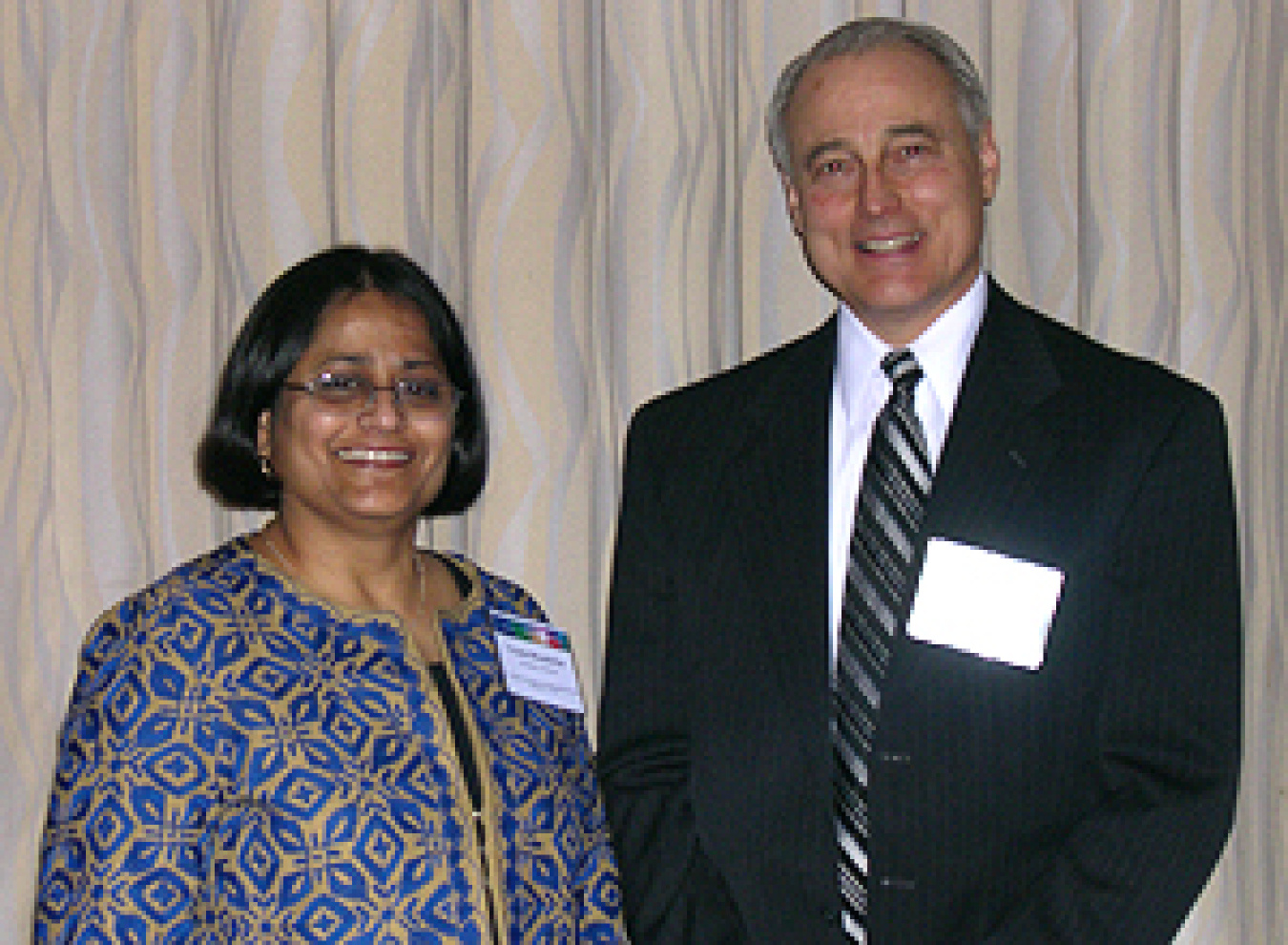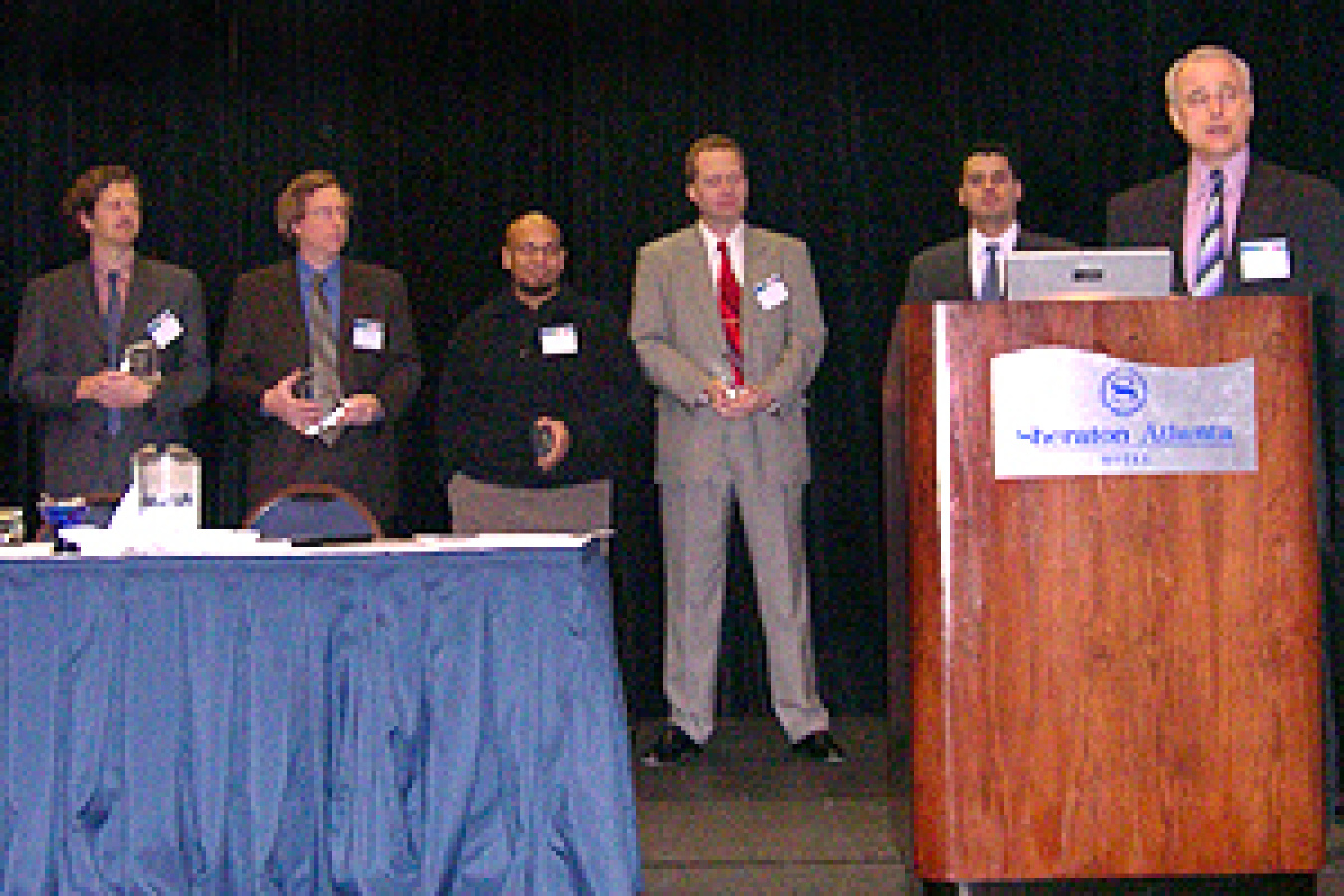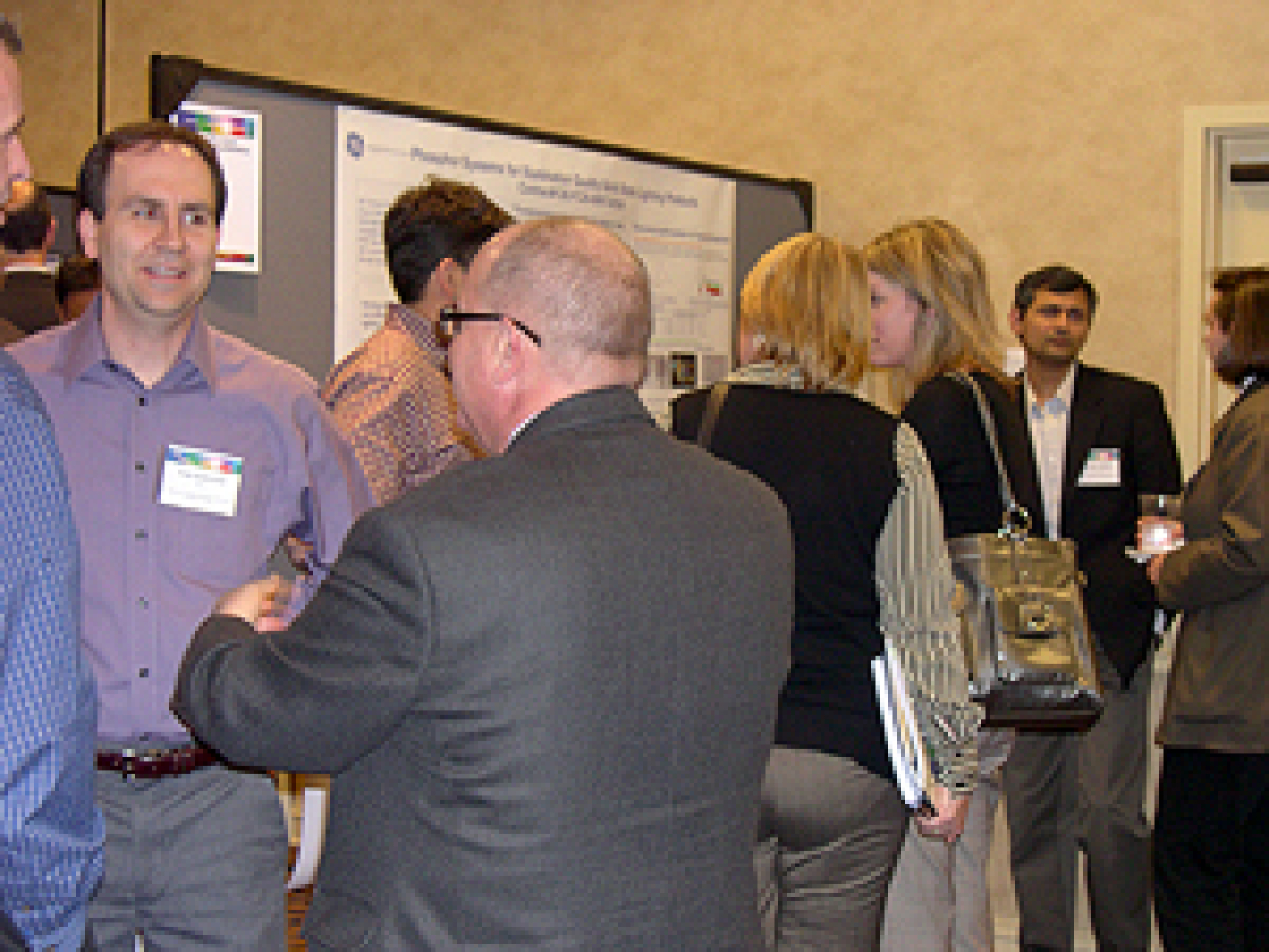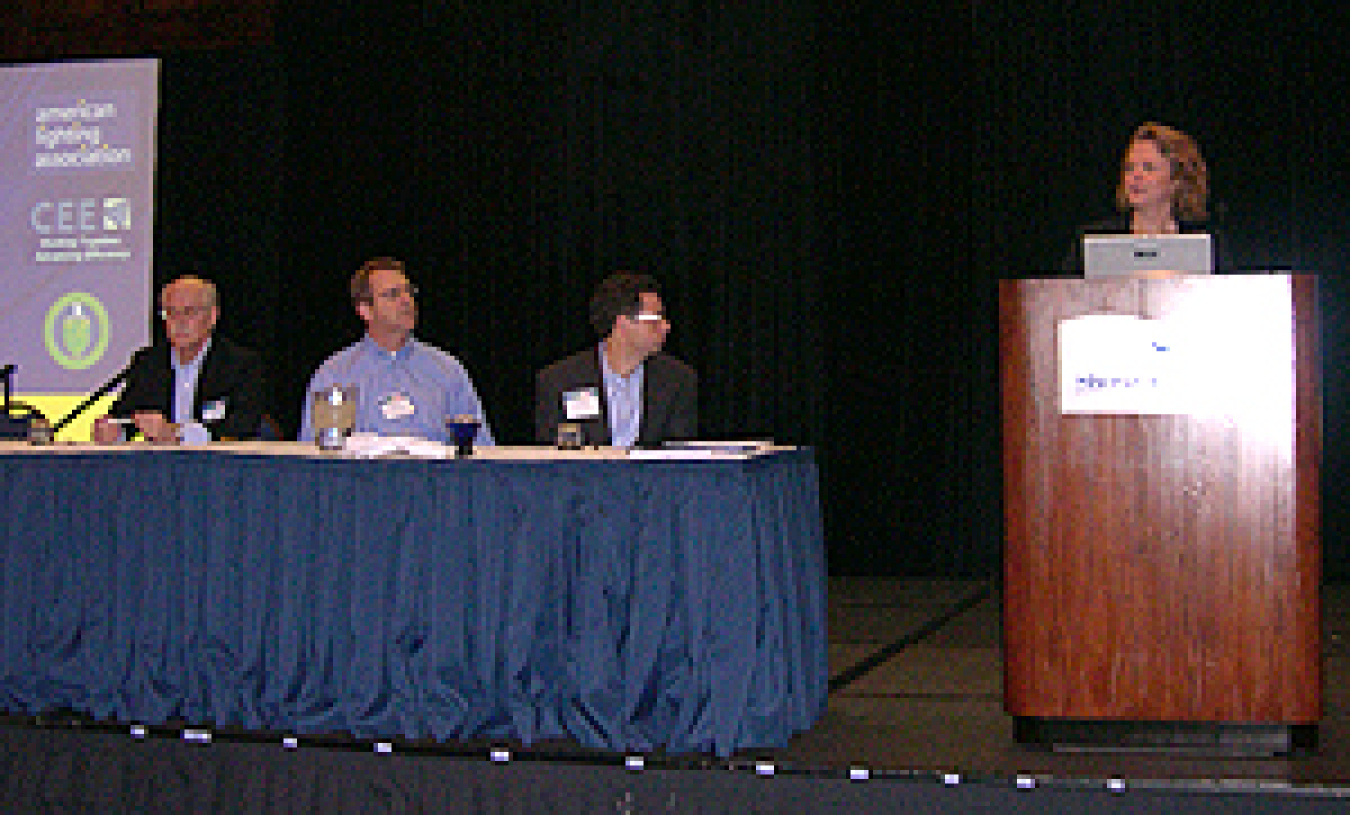
Vrinda Bhandarkar from Strategies Unlimited (left) and DOE Lighting Program Manager James Brodrick (right) teamed to kick off the 2008 DOE SSL R&D Workshop.
More than 300 SSL technology leaders from industry, research organizations, universities, and national laboratories gathered in Atlanta, GA, along with representatives from efficiency programs, utilities, and the lighting design community to participate in the DOE SSL R&D Workshop on January 29-31, 2008. DOE SSL Program Manager James Brodrick kicked off the workshop by highlighting recent signs of the progress and pace of SSL advances: the New Year's Eve debut of the new Times Square Ball, lit with Philips Luxeon LEDs; the first DOE Gateway demonstration of Beta LED streetlights in Oakland, CA; and the LR6 downlight from LED Lighting Fixtures, Inc., Grand Prize Winner in the 2007 Lighting for Tomorrow competition.
Brodrick also discussed plans to raise the bar, including a new competition for "Bright Tomorrow Lighting Prizes." The Energy Independence and Security Act (EISact 2007) includes provisions for $20M in prizes for a 60W incandescent replacement technology, a PAR 38 halogen replacement technology, and a 21st Century Lamp. More details will be announced in the coming months.
Vrinda Bhandarkar from Strategies Unlimited followed with an analysis of the high-brightness LED market, projected to reach $1 billion in 2011. Bhandarkar compared the paths of CFL adoption, red traffic signal market penetration, and the current status of LED "best in class," noting that "LED markets are growing, niche by niche, year by year."
Ann Arbor Plans for an LED City
Day 2 began with a presentation from David Konkle, Energy Coordinator for the City of Ann Arbor, who described Ann Arbor's plans for their "LED City" initiative. Konkle outlined the key drivers behind Ann Arbor's commitment to LED lighting, their strategies for funding new initiatives, and first steps: retrofitting more than 1000 downtown streetlights with LED streetlights.
Richard Karney from the U.S. Department of Energy followed with an overview of the new ENERGY STAR criteria for SSL, which include an innovative two-category approach that enables early participation of a limited range of products while setting more aggressive targets for future products. Ralph Tuttle from Cree, Inc. offered an update on DOE's partnership with the Next Generation Lighting Industry Alliance. In 2007, Alliance task groups provided support for development of the new ENERGY STAR criteria, updates to the DOE SSL R&D Multi-Year Plan, provisions in the new energy legislation for "Bright Tomorrow Lighting Prizes," and other activities related to accelerating market introduction of high performance SSL products.
DOE-Funded R&D Results

Left to right: James Ibbetson, Cree Inc.; Kevin Dowling, Philips Solid-State Lighting Solutions; Joseph Berry, National Renewable Energy Lab; Paul Burrows, Pacific Northwest National Lab; Brian D'Andrade, Universal Display Corp.; James Brodrick, DOE.
James Brodrick began the next session with an overview of the DOE SSL R&D portfolio budget and areas of focus. He concluded by recognizing four project teams for significant contributions in 2007: Cree, Inc.; the National Renewable Energy Laboratory/Pacific Northwest National Laboratory collaboration; Philips Solid-State Lighting Solutions; and Universal Display Corporation. Brodrick then introduced a series of presentations on significant 2007 project achievements and projects of interest for 2008:
- James Ibbetson discussed Cree's efforts to set new benchmarks for LED efficacy and brightness.
- Christian Wetzel described Rensselaer Polytechnic Institute's research to bridge the "green gap" in LED technology.
- Daniel Koleske offered an overview of SSL research activities conducted at Sandia National Laboratories.
- Brian D'Andrade discussed Universal Display Corporation's efforts to increase the efficiency and stability of white OLEDs.
- Yong-Seok Choi presented an overview of research conducted by the University of California, Santa Barbara, to extract more light from LEDs.
- Linda Sapochak discussed Pacific Northwest National Laboratory's approach for developing molecular dopants for bright, long-lived OLEDs.
- Kevin Dowling presented an overview of Philips Solid-State Lighting Solutions' efforts to create an integrated LED luminaire for general lighting.

An evening Poster Session/Reception featured all current DOE R&D projects and provided additional opportunity for discussion and networking.
Joel Chaddock, from DOE's National Energy Technology Laboratory, followed with an overview of the DOE solicitation and proposal evaluation process, offering guidance on preparing a comprehensive application. The afternoon concluded with a presentation from Fred Welsh, Radcliffe Advisors, on draft updates to the DOE SSL R&D Multi-Year Plan. Attendees were invited to review and comment on the revised priorities and targets in the draft update. DOE plans to finalize and publish the updated Multi-Year Plan in March 2008.
An evening Poster Session/Reception featured all current DOE SSL R&D projects, and provided attendees with additional opportunities for discussion, information exchange, and potential partnering.
What Lighting Designers Want from SSL
Samantha LaFleur, from the environmental design firm Atelier Ten, offered insights on market perceptions about SSL, highlighting the need to inform designers and specifiers so they can represent the technology accurately. LaFleur emphasized the importance of providing complete system solutions, pre-solving installation details, providing solid specification documents and technical support, and standing by products. Her final advice for fixture manufacturers: more choices and lower costs.
The next session featured a panel of speakers representing the Lighting for Tomorrow design competition. Ruth Taylor from Pacific Northwest National Laboratory (PNNL) introduced a series of presentations from the 2007 competition winners:

The Lighting for Tomorrow panel included (left to right): Terry Clark, Finelite; Gary Trott, LED Lighting Fixtures, Inc.; Jim Decker, Progress Lighting; Ruth Taylor, PNNL.
- Gary Trott from LED Lighting Fixtures, Inc. described the technology behind the LR6 Downlight and the value of participating in the competition, including independent validation of product performance claims.
- Terry Clark from Finelite discussed the underlying research that led to the development of Finelite's Personal Lighting System for offices, which uses a combination of task lighting and low ambient lighting to achieve significant energy savings.
- Jim Decker from Progress Lighting described the design and performance of the Strata Outdoor Wall Lantern, and offered perspective on what DOE and manufacturers need to do to facilitate market acceptance of SSL products.
Ruth Taylor concluded the session with a preview of the 2008 Lighting for Tomorrow SSL competition, which will feature three categories: fixtures that meet the new ENERGY STAR criteria; other decorative fixtures (e.g., chandeliers, sconces, table lamps); and a future LED showcase (fixtures using the world's highest efficiency LEDs). For more information, see http://www.lightingfortomorrow.com/.
Marc Ledbetter from PNNL followed with an overview of DOE's market introduction activities, which encompass CALiPER testing, Gateway demonstrations, buyer/user guidance, design competitions, standards and test procedure support, and the Technical Information Network. Ledbetter referenced the DOE Market Introduction Workshops held in 2007, and noted the next Market Introduction workshop is scheduled for July 2008. More information on the July workshop will be posted on this website in the coming months.
Next, My Ton from PNNL provided an overview of the DOE Gateway Demonstration program, sharing results from the Oakland streetlight demonstration and guidance on how to participate in future demonstrations. Alan Ruud and Eric Haugaard from Beta LED then provided a detailed comparison of LED technology vs. traditional technologies (e.g., metal halide, high intensity discharge, high pressure sodium) in applications such as parking lots and parking structures.
Mia Paget, PNNL, concluded the morning session with details from Round 4 CALiPER testing of commercially available SSL products. Round 4 testing included T8, MR16, and candelabra replacement lamps, downlights, desk/task lamps, undercabinet, and outdoor lighting. To date, more than 70 products have been tested through the CALiPER program.
Brodrick concluded the workshop with a reminder to participants that there are multiple ways to partner and participate with DOE, to help shape a transformation in lighting. To register for ongoing updates on DOE SSL program activities, visit /eere/ssl/solid-state-lighting.
